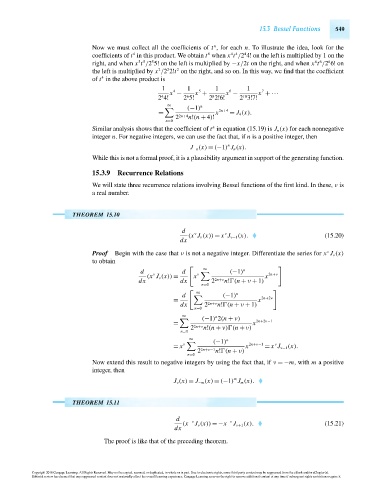Page 569 - Advanced_Engineering_Mathematics o'neil
P. 569
15.3 Bessel Functions 549
Now we must collect all the coefficients of t , for each n. To illustrate the idea, look for the
n
4
4
4 4
4
coefficients of t in this product. We obtain t when x t /2 4! on the left is multiplied by 1 on the
5
6
5 5
6 6
right, and when x t /2 5! on the left is multiplied by −x/2t on the right, and when x t /2 6! on
2
2
2
the left is multiplied by x /2 2!t on the right, and so on. In this way, we find that the coefficient
4
of t in the above product is
1 1 1 1
6
7
5
4
x − x + x − x + ···
8
4
10
6
2 4! 2 5! 2 2!6! 2 3!7!
∞ n
(−1)
= x 2n+4 = J 4 (x).
2 2n+4 n!(n + 4)!
n=0
n
Similar analysis shows that the coefficient of t in equation (15.19) is J n (x) for each nonnegative
integer n. For negative integers, we can use the fact that, if n is a positive integer, then
n
J −n (x) = (−1) J n (x).
While this is not a formal proof, it is a plausibility argument in support of the generating function.
15.3.9 Recurrence Relations
We will state three recurrence relations involving Bessel functions of the first kind. In these, ν is
a real number.
THEOREM 15.10
d
(x J ν (x)) = x J ν−1 (x). (15.20)
ν
ν
dx
ν
Proof Begin with the case that ν is not a negative integer. Differentiate the series for x J ν (x)
to obtain
∞ n
d ν d ν (−1) 2n+ν
(x J ν (x)) = x x
dx dx 2 2n+ν n!
(n + ν + 1)
n=0
∞ n
d (−1) 2n+2ν
= x
dx 2 2n+ν n!
(n + ν + 1)
n=0
∞ n
(−1) 2(n + ν) 2n+2ν−1
= x
2 2n+ν n!(n + ν)
(n + ν)
n=0
∞ n
(−1) 2n+ν−1
ν
= x ν x = x J ν−1 (x).
2 2n+ν−1 n!
(n + ν)
n=0
Now extend this result to negative integers by using the fact that, if ν =−m, with m a positive
integer, then
J ν (x) = J −m (x) = (−1) J m (x).
m
THEOREM 15.11
d
(x −ν J ν (x)) =−x −ν J ν+1 (x). (15.21)
dx
The proof is like that of the preceding theorem.
Copyright 2010 Cengage Learning. All Rights Reserved. May not be copied, scanned, or duplicated, in whole or in part. Due to electronic rights, some third party content may be suppressed from the eBook and/or eChapter(s).
Editorial review has deemed that any suppressed content does not materially affect the overall learning experience. Cengage Learning reserves the right to remove additional content at any time if subsequent rights restrictions require it.
October 14, 2010 15:20 THM/NEIL Page-549 27410_15_ch15_p505-562

